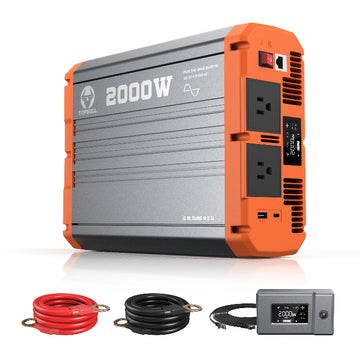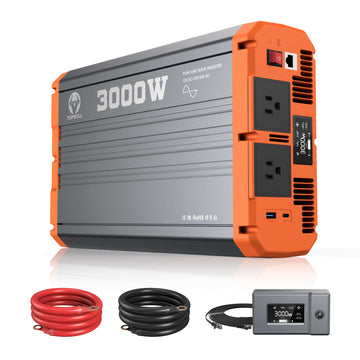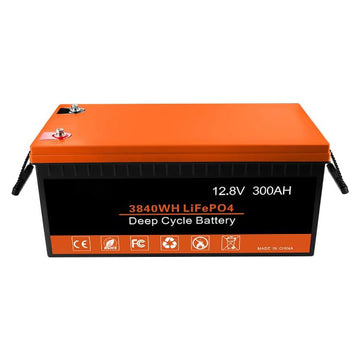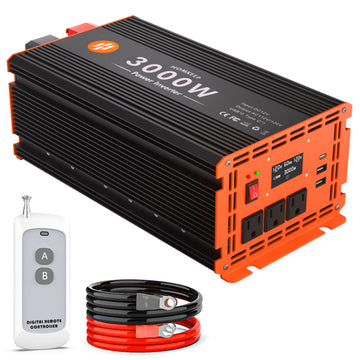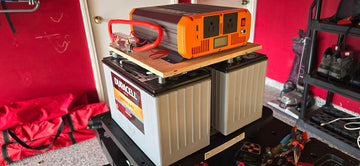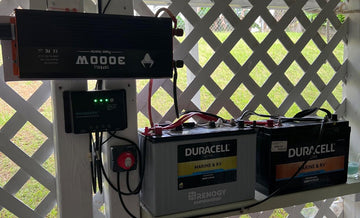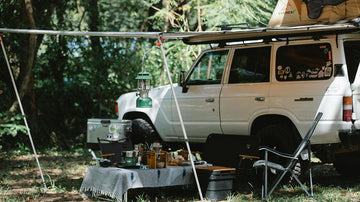Table of contents:
In the field of energy, off-grid inverters, as the key equipment connecting renewable energy systems (e.g., solar, wind, etc.) and end-loads, have a direct relationship with the performance and reliability of the entire energy system's stability and operational efficiency. With the rapid development and popularization of renewable energy technologies, there is a growing demand for efficient, stable and intelligent off-grid inverters. In this article, we will discuss the selection requirements of off-grid inverters in depth to help you pick the inverter that best suits your needs.
Difference between off-grid inverter and grid-connected inverter
Working Principle:
- Off-grid inverter: It is mainly used in occasions where there is no grid access or the power supply from the grid is unstable. It converts direct current (such as electricity generated by solar panels) into alternating current (AC) for use by the load, and can store electricity through the battery for emergency use.
- Grid-connected inverter: It is mainly connected between the grid and distributed power sources (e.g. solar power systems). It is responsible for converting the DC power generated by the distributed power source into AC power of the same frequency and phase as that of the grid, and is connected to the grid for power supply.
Application Scenario:
- Off-grid inverter: It is suitable for remote areas, islands, camping and other occasions where there is no power grid or the power supply from the grid is unstable.
- Grid-connected inverter: Widely used in household, commercial and industrial fields for grid-connected power generation from distributed power sources such as solar energy and wind energy.
Functional characteristics:
- Off-grid inverter: It usually has the functions of battery charging management, overload protection, short circuit protection, etc. to ensure the stable operation of the system.
- Grid-connected inverter: In addition to the basic conversion function, it also has the functions of maximum power point tracking (MPPT), islanding effect protection, etc. to improve system efficiency and safety.
Read more: What is the difference between off-grid inverters, grid-tied inverters and hybrid inverters?
How to choose a reliable off-grid inverter
Before selecting an off-grid inverter, we need to have a clear and in-depth understanding of its application scenarios and requirements. Off-grid inverters, as a key component of a standalone power system, are mainly tasked with converting DC power to AC power and providing stable power to various electrical devices. Therefore, understanding the needs of an off-grid inverter is actually clarifying what kind of role we expect it to play under what kind of environment and conditions.
The first thing we need to consider is the power requirement of the inverter. This depends on the total power of the electrical equipment you plan to use and the number of devices in use at the same time. For example, if you are planning to set up a home solar system in a remote area, then you need to estimate the total power of the electrical devices that are used in your home on a daily basis so that you can choose an off-grid inverter with the right power.
Secondly, we also need to consider the output voltage and frequency of the inverter. Different electrical devices may have different voltage and frequency requirements, so we need to make sure that the selected inverter can provide the voltage and frequency that meet the requirements of the devices.
In addition, the stability and durability of the inverter is also an important factor we need to consider. Since an off-grid inverter usually operates without grid support, it needs to have the ability to operate stably in a variety of environments, and it also needs to be durable enough to cope with a variety of unforeseen situations that may arise.
Finally, we also need to consider the additional features and intelligence of the inverter. For example, some advanced off-grid inverters may have additional functions such as battery charge management, overload protection, short circuit protection, etc. These functions can further improve the stability and safety of the system. Meanwhile, some intelligent off-grid inverters may also have the ability of remote monitoring and control, which can facilitate the user to understand the operating status of the system at anytime and anywhere and make necessary adjustments.
Read More: How to choose the best inverter for your needs?
Key factors in selecting an off-grid inverter explained in detail
How much power do I need?
Determine the total power of the load
First, you need to list all the electrical devices you intend to connect to the inverter and consult their power labels or manuals to determine the power requirement of each device. Add up the power of these devices to get the total power of the load.
For example, suppose you have the following devices:
- Laptop: 60W
- TV: 100W
- Refrigerator: 150W
- LED lights (5, 10W each): 50W
Then, the total power of the load is: 60W + 100W + 150W + 50W = 360W.
Consider peak power demand
Some electrical devices may require higher power at startup than during normal operation, which is called peak power. To ensure that the inverter is able to cope with this brief period of high power demand, you may need to choose an inverter with a power slightly greater than the total power obtained by simple summation.
Typically, you can estimate the peak power demand as 1.2 to 1.5 times the total power of the load. Take the above example as an example, the total load power is 360W, if we choose a factor of 1.2, then the peak power demand is 360W * 1.2 = 432W.
Selecting the right inverter power
Finally, based on the calculated peak power demand, select an inverter power slightly larger than this value. This is to ensure that the inverter can work consistently and stably while avoiding overloading.
Therefore, for the example above, you may need to select an inverter with a power of 500W or more. Please note that choosing an inverter with too much power, while providing greater flexibility, can also increase costs and unnecessary energy losses.
Conversion efficiency of the inverter
Conversion efficiency is an important measure of an inverter's performance. It indicates the percentage of energy that an inverter is able to retain when converting DC power to AC power. An efficient inverter reduces energy loss and improves energy utilization.
It is calculated as follows: Conversion efficiency (%) = Inverter output power / Inverter DC input power × 100%.
The conversion efficiency of the inverter is affected by many factors, including but not limited to the following:
- Design and manufacturing process: The design and manufacturing process of the inverter directly determines the performance and loss of its internal components, thus affecting the conversion efficiency.
- Operating Temperature: The efficiency of an inverter usually decreases as the temperature increases. Therefore, operation at higher temperatures may reduce the conversion efficiency.
- Load Characteristics: The efficiency of an inverter is usually highest within a specific load power range. If the load power is below or above this range, the efficiency will decrease.
- Input Voltage Range: The efficiency of an inverter is usually highest within a specific input voltage range. If the input voltage is outside this range, the efficiency will also decrease.
- Output Voltage Waveform: A purer sine waveform will usually have a higher efficiency, while a more impure waveform (such as a square wave or harmonics) may reduce efficiency.
- Converter topology: Different converter topologies have different efficiency characteristics. For example, resonant converters typically have higher efficiencies than traditional PWM (pulse width modulation) converters.
When choosing an inverter, check its conversion efficiency and select a product with high efficiency. This will help reduce energy waste and save you money on your electric bill.
Pure or Modified Sine Wave
The type of waveform output from your inverter is critical to the operation of your electrical equipment. For off-grid users, choosing a pure sine wave inverter is the more suitable and recommended option.
Pure sine wave inverters provide a higher quality power output, similar to (or better than) the quality of power supplied from the grid. This high quality output ensures proper operation of electrical equipment, reduces the risk of damage due to waveform distortion, and extends the life of the equipment. In addition, pure sine wave inverters are also friendlier to sensitive equipment (such as computers), avoiding possible damage or abnormal operation.
In contrast, corrected sine wave inverters, while less costly, provide a lower quality power output that may cause equipment such as motors, pumps, and compressors to run hotter, wear out faster, and possibly even damage some sensitive equipment. In addition, corrected sine wave inverters can cause background noise in stereos and degrade the video and audio quality of televisions and certain other devices.
To quickly distinguish between types of inverters, look at the inverter's total harmonic distortion (THD) rating. The rule of thumb is to choose a pure sine wave inverter with a THD of 5% or less to ensure a high quality power output and avoid potential problems.
Therefore, choosing a pure sine wave inverter is a more sensible and reliable choice for off-grid users.
Stability and durability
Stability and durability are important indicators for assessing the quality of an inverter. You need to choose an inverter that can operate stably in a variety of environments and has sufficient durability. This includes taking into account factors such as the inverter's thermal performance, protective design, and material quality. A high-quality inverter should have an excellent heat dissipation system to prevent overheating, and it should have a sufficient level of protection against dust, humidity, and other harsh environments.
View Technical Specifications
Here are some some other technical specifications to consider:
- Efficiency: This is a measure of the amount of power delivered from the batteries to your home when the inverter is operating in perfect conditions. A good peak efficiency rating is around 94% to 96%.
- Self-consumption or no-load current draw: How much power does your inverter draw sitting there? Obviously, you want it to be as low as possible.
- Surge capacity: How much short-term overload can the inverter handle before it "trips"? Some appliances, such as pumps or refrigerators, require up to 2x to 3x the operating power to start.
- Battery charger output: Many off-grid inverters include a battery charger for charging the batteries during the winter months using a backup generator. The battery charger will have a rating, usually in amps. Most decent off-grid inverters will come with a battery charger in the 50-100 amp DC range.
- Temperature Range:Inverters are sensitive to extreme heat. If you plan on installing your system in a garage or anywhere that may be exposed to extreme temperatures, pay careful attention to the temperature range.
- Warranty: Warranties start at 1 year and usually run 3-5 years, with a few manufacturers offering 10-year warranty extension options.
You can usually find information about all of these features on the product specification sheet. Consult your solar technician for help comparing and selecting the right inverter.
2025 Best Off-Grid Inverter Recommendations
For how to choose an off-grid inverter still needs to be based on your specific needs and application scenarios, the following are the high quality inverters we recommend:
Our selection: RV and marine off-grid inverters
TOPBULL 3000W Pure Sine Wave Inverter
Product Features:
- 3000W 100% continuous output power with peak surge power up to 6000W. pure sine wave technology to protect your electrical equipment.
- 100% pure copper high-frequency transformers and ultra-flexible cables for low power conversion losses, low no-load energy consumption and high power conversion efficiency.
- 7 major protection features. Sturdy aluminum housing, dual intelligent fans, no heat generation, low noise and long product life.
- Built-in 1 USB port, 1 type-c port and 2 AC outlets, 20 feet wired remote control, meet your diverse power needs.
Our selection: the best portable off-grid inverters
TOPBULL 2000W Pure Sine Wave Inverter
Product Features:
- 2000W of 100% continuous output power with a peak surge power of up to 4000W. Pure sine wave technology protects your electrical equipment.
- 100% pure copper High frequency transformer and ultra-flexible cables for low power conversion losses, low no-load energy consumption & high power conversion efficiency.
- 7 major protection features. Sturdy aluminum casing, dual intelligent fans, no heat, low noise, long product life.
- Built-in 1 USB port, 1 type-c port and 2 AC outlets, 20 feet wired remote control, meet your diverse power needs.
TOPBULL inverters are available in a variety of sizes and are relatively affordable and easy to set up, which makes them an excellent choice for off-grid living, RV, marine, and home use.
FAQ about off-grid inverters
How to install off-grid inverter?
- Choose a suitable installation location: Make sure the installation location is well ventilated, dry and free from direct sunlight.
- Connect the wires: Connect the input of the inverter to the output of the renewable energy system (e.g. solar system or wind system), and connect the output of the inverter to the power-using equipment.
- Power-on test: After completing the installation, conduct a power-on test to ensure that the inverter can work properly.
What are the common faults of off-grid inverter and how to deal with them?
- The inverter cannot start: Check the power switch, battery connection and power level. If the power switch is faulty, it needs to be repaired or replaced; if the battery is low, it needs to be charged.
- Inverter alarm: It may be due to load, abnormal voltage or battery failure. It is necessary to cut off the extra load, charge the battery or contact a professional maintenance personnel to deal with it.
- DC over-voltage: Due to the rise of component open-circuit voltage and working voltage, the temperature coefficient needs to be considered at the design stage. If DC overvoltage occurs, the relevant settings need to be checked and adjusted.
- Leakage faults: caused by installation quality, low quality equipment or water ingress. Leakage points need to be checked and repaired, e.g. by replacing low quality DC connectors or components.
How to determine if the off-grid inverter needs to be replaced?
- If the inverter fails frequently or does not work properly, replacement may need to be considered.
- Replacement should also be considered if the inverter's efficiency is significantly reduced and it is unable to meet the demand for electricity.
- As technology advances and new types of inverters are introduced, replacement with a new type of inverter may also be considered if the old type of inverter is unable to meet current demand or if there are safety concerns.

